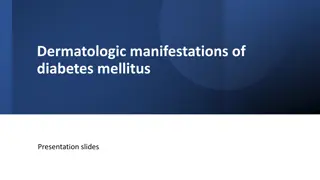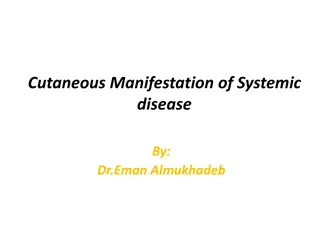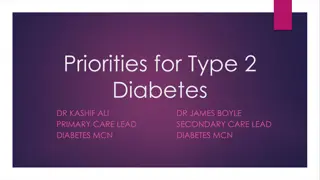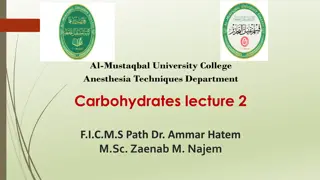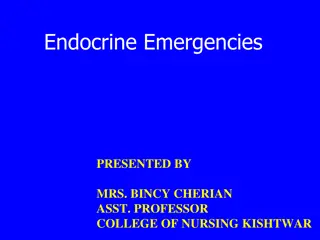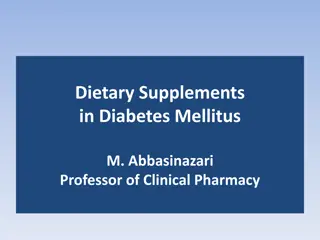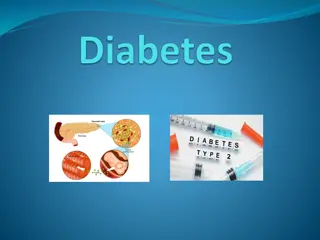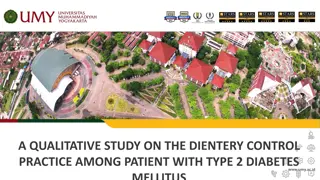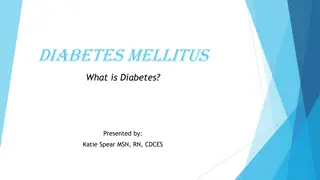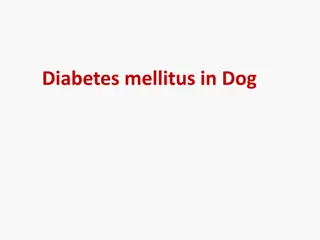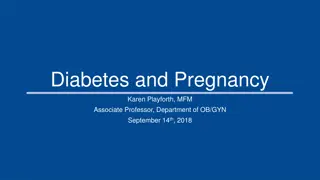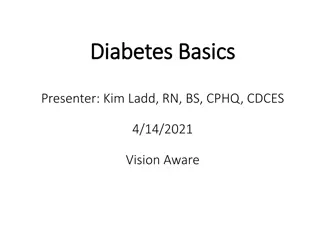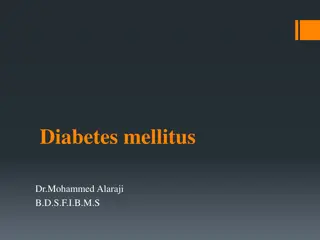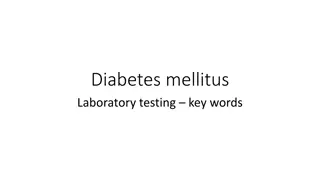DIABETES MELLITUS
Diabetes Mellitus is a chronic condition characterized by high blood sugar levels. There are different types of diabetes, including Type I and Type II, each with distinct characteristics and complications. This article covers the classification of diabetes by WHO, the differences between Type I and Type II diabetes, and important information about the disease.
Download Presentation

Please find below an Image/Link to download the presentation.
The content on the website is provided AS IS for your information and personal use only. It may not be sold, licensed, or shared on other websites without obtaining consent from the author.If you encounter any issues during the download, it is possible that the publisher has removed the file from their server.
You are allowed to download the files provided on this website for personal or commercial use, subject to the condition that they are used lawfully. All files are the property of their respective owners.
The content on the website is provided AS IS for your information and personal use only. It may not be sold, licensed, or shared on other websites without obtaining consent from the author.
E N D
Presentation Transcript
DIABETES MELLITUS
Greek- Diabetes-siphon, Mellitus-honey (sweet) State of chronic hyperglycemia, resulting from diversities of etiologies, environmental and genetic acting jointly. Underline cause is defective production or action of insulin, a hormone that controls glucose, fat and amino acid metabolism. Metabolic syndrome-polyuria, polyphagia, polydypsia, hyperglycemia and glycosuria due to absolute or relative deficiency of insulin. Chronic hyperglycemia leads to number of complications-cardiovascular, renal, neurological ocular and others such as intermittent infections.
CLASSIFICATION by WHO 1- DIABETES MELLITUS a) Type I or insulin dependent diabetes mellitus (IDM) b) Type II or Non-insulin dependent diabetes mellitus (NIDM) c) Malnutrition related diabetes mellitus (MRDM) d) Others types-(secondary to pancreatic, hormonal, drug-induced, genetic or other abnormalities.) 2- Impaired Glucose Tolerance (IGT) 3-Gestational Diabetes Mellitus (GDM)
DIFFERENCE BETWEEN TYPE I AND TYPE II D.M. TYPE I IDDM Juvenile type of DM Common below 30 yrs of age Sudden in onset Thin built, obesity not risk factor HLA linked genetic predisposition Associated with other autoimmune diseases Acute metabolic decomposition-sudden death TYPE II NIDDM Maturity onset type DM Among people above 30 yrs age Gradual in onset Usually obese, obesity risk factor Not HLA linked Not associated with other autoimmune diseases Chronic metabolic decompensation leads to complication Slowly resulting in irreversible disability and death Complication sudden and are fatal Not associated with obesity and under activity Associated with obesity and under activity Common among men Common among women No family history Usually present
TYPE 1 DIABETES Body does not make insulin Usually develops in children or young adults Normal Weight Must take insulin daily to live
TYPE I DIABETES MELLITUS (IDDM)- Most severe form of disease. Onset abrupt. Usually seen in individual less than 30 years of age. Lethal unless promptly diagnosed and treated. Immune-mediated over 90% and idiopathic in 10 %. Proportion of IDDM is less than 15% mostly in children below 30 years.
SYMPTOMS OF TYPE 1 DIABETES MELLITUS Feeling more thirsty than usual Dry mouth Fruity breath Frequent urination Unintentional weight loss Increase in appetite Lack of energy, drowsiness
Skin Problems Many people with type 1 diabetes experience uncomfortable skin conditions, including: Bacterial infections Fungal infections Itching, dry skin, poor circulation
When blood sugars are not controlled, type 1 diabetes can cause more serious symptoms, such as: Numbness or tingling in the feet Blurred vision Low blood sugar/hypoglycaemia Loss of consciousness
More Dangerous Signs: Ketoacidosis Without treatment, type 1 diabetes deprives cells of the sugar they need for energy. Body starts burning fat for energy instead, which causes ketones to build up in the blood. These are acids that can poison the body. High levels of acid in blood and the other abnormalities that result from the change in blood's pH level may trigger a life-threatening coma known as diabetic ketoacidosis. This is an emergency that must be treated quickly and often times in the hospital.
Type 1 vs. Type 2 Diabetes In type 1 diabetes, the body's immune system mistakenly attacks and destroys the pancreatic cells that produce insulin. In type 2 diabetes, the pancreas is not under attack and usually produces enough insulin. But for numerous reasons, the body doesn t use the insulin effectively. The symptoms of the two forms are similar, but usually come on more rapidly in people with type 1.
Rate of destruction of pancreatic cell is quite variable. Usually associated with ketosis in untreated state. Mostly in children, highest among 10-15 years age group but occasionally in adults. Catabolic disorder in which insulin is virtually absent, plasma glucagon is elevated and pancreatic cells fail to respond to all insulinogenic stimuli.
Exogenous insulin is required to reverse the catabolic state, prevent ketosis, reduce hyperglycemia and reduce blood glucose.
TYPE 2 DIABETES Cells do not use insulin properly Not enough insulin being produced Generally develops in adulthood Becoming more common in children due to obesity Common in persons who are overweight Many different ways to treat, including diet and exercise, pills, or insulin
TYPE II DIABETES (NIDM)- More common. Discovered by change. Gradual in onset. Mainly in middle aged and elderly. Mild, slow to ketosis and compatible to long survival if treated adequately. Clinical picture is complicated by present of other disease process.
IMPAIRED GLUCOSE TELERANCE (IGT)- Intermediate AT RISK GROUP -between diabetes mellitus and normality. Can only defined by oral glucose tolerance test.
The WHO recommendations for the diagnostic criteria for diabetes and intermediate hyperglycemia Diabetes Fasting plasma glucose Or 2-h plasma glucose Impaired Glucose Tolerance (IGT) Fasting plasma glucose And 2-h plasma glucose 7.0 mmol/l (126 mg/dl) > 11.1 mmol/l (200mg/dl) < 7.0 mmol/l (126 mg/dl) 7.8 mmol and <11,1 mmol/l (140mg/dl to 200 mg/dl) Impaired Fasting Glucose (IFG) Fasting plasma glucose 6.1 to 6.9 mmol/l (110mg/dl to 125mg/dl) And ( if measured)
INSULIN RESISTANCE SYNDROME (SYNDROME X) In obese patient with type 2 diabetes, the association with hyperglycemia, hyoerinsulinaemia, dyslipidaemia and hypertension, which leads to coronary artery disease and stroke may result from genetic defect producing insulin resistance, with later been exaggerated by obesity.
Insulin resistance predisposes to hyperglycemia, which results in hyoerinsulinaemia (which may or may not of sufficient magnitude to correct hyperglycemia) and this excessive insulin level contributes to high levels of triglycerides and increased sodium retention by renal tubules, inducing hypertension. High level of insulin stimulate endothelial proliferation to initiate atheloscelosis.
PROBLEM STATEMENT WORLD- Diabetes is an iceberg disease. Increase in both prevalence and incidence of type 2 diabetes occurred globally. Dramatic in societies in economic transition, in newly industrialized and developing countries. 347 million cases, more than 90% are type 2 diabetes.
PROBLEM STATEMENT cont.. In 2008 1.2 million people died from consequences of high blood sugar. More than 80 % death occur in low and middle income countries. Apparent prevalence depends upon diagnostic criteria used in epidemiological surveys. Global prevalence of diabetes in 2008 10% in adults aged 25+
PREVALENCE OF DIABETES IN ADULT POPULATION (AGED 20 YEARS) BY YEAR AND REGION Region 1995 (%) 2000 (%) 2005 (%) World 4.0 4.2 5.4 Developed countries 5.9 6.2 7.6 Developing countries 3.3 3.5 4.9 India 3.8 4.0 6.0
List of diabetes with highest number of estimated cases of diabetes for 2000 and 2030 2000 Country 2030 Country People with diabetes (million) 31.7 20.8 17.7 8.4 6.8 5.2 4.6 4.6 4.3 3.2 People with diabetes (million) 79.4 42.3 30.3 21.3 13.9 11.3 11.1 8.9 7.8 6.7 India China US Indonesia Japan Pakistan Russian federation Brazil Italy Bangladesh India China US Indonesia Pakistan Brazil Bangladesh Japan Philippines Egypt
PROBLEM STATEMENT cont.. Highest prevalence in Eastern Mediterranean Region and Region of Americas (11% of both sexes) and lowest in WHO European and Western Pacific Region (9% of both sexes). Magnitude of diabetes and other abnormalities of glucose tolerance are higher if impaired fasting and impaired glucose tolerance are included. Low income countries-lowest prevalence (8% of both sexes) and upper-middle income group countries highest (10% of both sexes).
PROBLEM STATEMENT cont.. Unfavorable lifestyles and dietary habits are associated with urbanization are most important factors for development of diabetes. Twice in urban area than rural area. Ethnic, presumably genetic vulnerability of Asians subjected to unfavorable lifestyles. Bangladesh, India and Indonesia have shown increase in prevalence rate of disease in both rural and urban
PROBLEM STATEMENT cont.. If undiagnosed or inadequately treated, develop multiple chronic complications leading to irreversible disability and death. Coronary heart disease and stroke more common in diabetics. Micro vascular complications-diabetic renal disease and diabetic retinopathy and neuropathy resulting in deterioration of quality of life and premature death. Five most important determinants of cardiovascular disease.
PROBLEM STATEMENT cont.. Lower limb amputation 10 times more common. Metabolic disorders in pregnant women as well as those caused by gestational diabetes-a high health risk. Unfortunately inadequate awareness about real dimension of problem among general population. Lack of awareness about existing interventions for preventing disease and management of complications.
PROBLEM STATEMENT cont.. Inadequacies in primary health care systems, not posed to design in to cope with additional challenges by non-communicable diseases results in poor detection of cases, suboptimal treatment and insufficient follow up leading to unnecessary disabilities and severe complications and early death.
PROBLEM STATEMENT cont.. Age-adjusted mortality rate are 1.5-2.5 higher among diabetes as compared to general population. Caucasian population mortality attributable to CVD. Indian and American Indian renal diseases. In some developing societies infection are important cause of death.
PROBLEM STATEMENT cont.. NIDM-silent, chronic, often unidentified killer mostly among adult population. Develop symptoms of ketoacidosis and often die since majority do not access to adequate medical treatment, since insulin is not available or too expensive. Prevalence of type I diabetes in Asia is low, accounting 9.7% of all D.M. cases.
PROBLEM STATEMENT cont.. INDIA- An increased susceptibility to D.M. In 2004- 37.7 million cases. 21.4 million in urban area and 16.3 million in rural area. Mortality-1.09lac, 62.5 thousand in urban and 46.6 thousand in rural 2.2million DALY lost.
NATURAL HISTORY EPIDEMIOLOGICAL DETERMINANTS- 1-AGENT- Insulin deficiency-absolute in type I and partial in type 2 diabetes.
NATURAL HISTORY cont May be due to- a)Pancreatic disorders-inflammatory, neoplastic and other disorders such as cystic fibrosis. b) Defects in formation of insulin-synthesis of abnormal biologically less active insulin. c) Destruction of beta cells-viral infection and chemical agents. d) Decreased insulin sensibility-due to decreased number of adipocyte and monocyte insulin receptors.
NATURAL HISTORY cont e) Genetic defects-mutation of insulin gene. f) Autoimmunity-insulin response to glucose is genetically controlled. Overall effects- Reduced utilization of glucose hyperglycemia accompanied by glysuria
NATURAL HISTORY cont 2-HOST FACTORS- a) AGE- Diabetes may occur at any age. Prevalence rises steeply with age. In middle years of life and thereafter begin to rise in frequency. Malnutrition related diabetes affects large number of young people. Prognosis poor in younger who tends to develop complications earlier.
NATURAL HISTORY cont b) SEX- Some countries Male-female ratio equal-U.K. In South East Asia male are more effected than female. c) GENETIC FACTORS- Genetic nature of diabetes. d)GENTIC MARKER- type I diabetes associated withHLA-B8and B15and more powerfully with HLA-DR3 and DR4. Type2 diabetes not HLA-associated.
NATURAL HISTORY cont e) IMMUNE MECHANISM- Both cell-mediated and humoral-activity against islet cells. Defective immunological mechanism, under influence of some environmental trigger , attack their own insulin producing cells. f) OBESITY- Central adiposity risk factor of type 2 diabetes and risk to both duration and degree of obesity.
NATURAL HISTORY cont Waist circumference or waist to hip ratio more powerful determinant of type 2 diabetes than BMI. Central obesity also determinant of insulin resistance. Obesity reduces numbers of insulin receptors on target cells. Voluntary weight loss improve insulin sensitivity and reduce risk of progression IGT to type 2 diabetes.
NATURAL HISTORY cont Some obese are not diabetic so obesity is not absolute cause of diabetes. Physical inactivity and /or deficiencies of specific nutrients may also involved. Obesity-no role in type I diabetes. g) MATERNAL DIABETES- Offsprings of diabetic pregnancies including gestational diabetes are large and heavy at birth, tend to develop obesity at childhood and at high risk of developing type 2 diabetes at early age.
NATURAL HISTORY cont 3-fold higher risk in those children born after development of diabetes in mothers. Maternal diabetes associated with IUGR and LBW when associated with rapid growth catch up later increase risk of developing diabetes.
NATURAL HISTORY cont ENVIRONMENTAL FACTORS- a) SEDENTARY LIFE STYLE- Lack of exercise may alter interaction between insulin and its receptors. b) DIET- High saturated fat intake. Higher proportions of saturated fatty acids in serum lipids or muscle phospholipids- higher fasting insulin, lower insulin sensibility and higher risk of type 2 diabetes.
NATURAL HISTORY cont Higher unsaturated fatty acids from vegetable sources and polyunsaturated fatty acids reduce risk of type2 D.M. and lower fasting 2-hours glucose concentrations. Higher proportion of long chain polyunsaturated fatty acid in skeleton muscle phospholipid increase insulin sensivity. Replacement of saturated by unsaturated fatty acids leads to glucose tolerance and insulin sensivity.
NATURAL HISTORY cont Long-chain polyunsaturated fatty acid do not confer additional benefit over monounsaturated fatty acids. When total fat intake (>37% of total energy intake) quality of dietary fat appear to have little effect. c) DIETARY FIBRE- High intake of dietary fibre reduce blood glucose and insulin level and IGT. Minimum intake of 20 gram fibre is needed
NATURAL HISTORY cont d) MALNUTRITION- Malnutrition in early infancy and childhood may result in partial failure of cells function e) ALCOHOL- Can increase risk of diabetes by damaging pancreas and liver and increase in obesity. f) VIRAL INFECTION- Rubella, mums and human coxsackie virus B4. Viral infection may trigger in immunogenetically susceptible people a sequence of events resulting in destruction of cells


